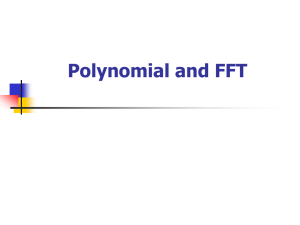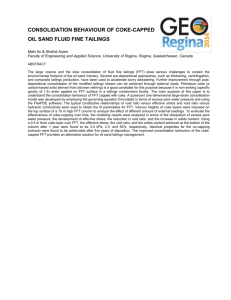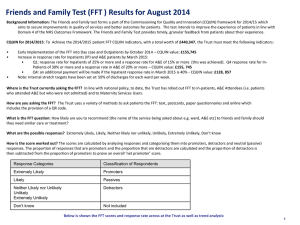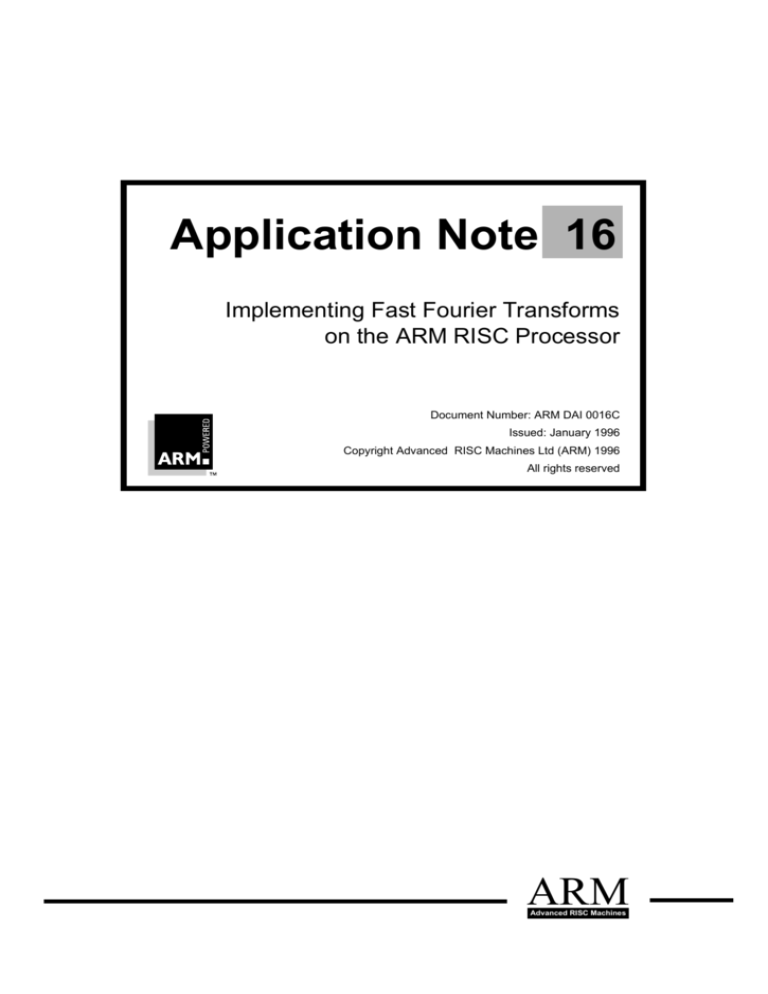
Application Note 16
Implementing Fast Fourier Transforms
on the ARM RISC Processor
Document Number: ARM DAI 0016C
Issued: January 1996
Copyright Advanced RISC Machines Ltd (ARM) 1996
All rights reserved
ARM
Advanced RISC Machines
Proprietary Notice
ARM and the ARM Powered logo are trademarks of Advanced RISC Machines Ltd.
Neither the whole nor any part of the information contained in, or the product described in, this application note may be
adapted or reproduced in any material form except with the prior written permission of the copyright holder.
The product described in this application note is subject to continuous developments and improvements. All particulars
of the product and its use contained in this application note are given by ARM in good faith. However, all warranties
implied or expressed, including but not limited to implied warranties or merchantability, or fitness for purpose, are
excluded.
This application note is intended only to assist the reader in the use of the product. ARM Ltd shall not be liable for any
loss or damage arising from the use of any information in this application note, or any error or omission in such
information, or any incorrect use of the product.
Change Log
Issue
Date
By
Change
A
B
C
June 94
Dec 94
Jan 96
PE/SG
PB
AP
Document creation
Reformatted into FrameMaker
Major edits
ii
Application Note 16
ARM DAI 0016C
Fast Fourier Transforms
1
Introduction
The Fast Fourier Transform, known as the FFT, is an important algorithm used in
digital signal processing. It converts a sampled signal, such as an audio or other
waveform captured by an analog to digital converter, into a frequency spectrum. The
Inverse Fourier Transform reverses the process.
This application note describes the implementation of the FFT using the ARM
processor. How to call the algorithm from C or assembler is described in 2 Calling the
algorithm on page 2. The performance statistics are given in 3 Performance on page
5. The mathematical theory concerning how the algorithm works is described in A
How the Algorithm Works on page 11.
The implementation makes use of many ARM features to maximize performance
including the following:
•
The load and store multiple instructions greatly improve the handling of
transfers between main memory and the general purpose registers.
•
The combined arithmetic/logical and shift operations in a single instruction
reduce the number of cycles needed for important computational parts of the
program.
•
Conditional execution of all instructions reduces the number of branches
needed.
•
The large number of general purpose registers is used to reduce the number
of loads and stores to a minimum.
A number of optimizations are implemented, and conditional assembly is used to
make them optional.
Application Note 16
ARM DAI 0016C
1
Fast Fourier Transforms
2
Calling the algorithm
2.1
Input and output
The algorithm takes four values on input:
•
A pointer x to the input data consisting of N complex numbers x[0], ...., x[N-1].
Each complex number consists of a 32-bit integer containing the real part
followed by a 32-bit integer containing the imaginary part and so is 8 bytes
long.
•
A pointer y to the output buffer for the transformed array to be stored. This
buffer must be at least 8*N bytes (the same size as the input x buffer).
•
An integer LogN giving the base 2 logarithm of the number of points N in the
fourier tranform.
A flag direction which is either:
1
for a forward transform
0
for an inverse transform
On output, the algorithm returns an integer:
•
zero
if the transform was successful (in which case the y array contains the
answer)
nonzero
if the transform was not successful (for example the trigonometry
table was not large enough for the given size of N)
The forward FFT performs the calculation specified by the formula:
1
y [ k ] = ---N
N–1
∑ x [ n ] ( cos ( nkω ) – i sin ( nkω ) ) ,
n=0
where ω = 2π ⁄ N . The 1/N scaling in front prevents any overflows within the
algorithm. We will write y = FFT ( x ) for the forward transform.
The Inverse transform performs the calculation:
1
y [ k ] = ---N
N–1
∑ x [ n ] ( cos ( nkω ) + i sin ( nkω ) ) ,
n=0
which we will write as
2.2
y = IFT ( x ) .
Calling the algorithm from C
To call the algorithm from C, include the header fft.h which declares the type
complex and the function FFT as:
int FFT(complex *x, complex *y, int LogN, int direction);
Call the algorithm with x, y, LogN, direction set up as described above. Note the
following points:
2
Application Note 16
ARM DAI 0016C
Fast Fourier Transforms
2.3
•
The buffers x and y may coincide. In this case the FFT is said to be done in
place rather than out of place.
•
To prevent overflow within the algorithm, the real and imaginary values in the
array x should be sign extended 16-bit quantities (between -32768 and
+32767).
•
When using the optimized version of the FFT, the smallest value of N allowed
is 16 (LogN must be at least 4). N must always be a power of 2. The largest
value of N allowed depends on the size of the trigonometry table included
when the FFT code is assembled.
Calling the algorithm from assembler
To call the algorithm from assembler, import the symbol FFT and set up the registers
as follows:
•
set R0 to the address of the input buffer x
•
set R1 to the address of the output buffer y
•
set R2 to LogN
•
set R3 to direction (0 or 1)
• R13 must point to a full descending stack
Call the algorithm via BL FFT. On exit R0 will contain the exit code (0 if successful),
R1-R3 and R14 will have been corrupted and R4-R13 preserved.
See 2.2 Calling the algorithm from C on page 2 for the restrictions on LogN and the
contents of the x array.
2.4
Performing real FFTs
If the values placed in x are all real (zero imaginary part), the speed of the forward FFT
can be almost doubled. The function REALFFT performs this and is declared in fft.h
as:
int REALFFT(int *input, complex *output, int LogN);
The REALFFT function calculates the FFT of 2N real values using an N point complex
FFT. The input buffer should be filled with the real parts of x[0],...., x[2N-1] (thus the
size of the buffer is 8*N bytes) and on output the output buffer will contain the first half
of the FFT y[0],..., y[N-1]. The second half of the transform can be calculated by
symmetry, for in the real case y[2N-k] is the complex conjugate of y[k].
Note that the input and output buffers are the same size (8*N bytes) and may coincide.
The same restrictions on the size of LogN and the contents of x apply as for the FFT
algorithm, with the addition that the trigonometry table must be at least size 2N.
Application Note 16
ARM DAI 0016C
3
Fast Fourier Transforms
2.5
Changing the size of the trigonometry table
The trigonometry table fft_table.s is generated by the C program trig.c
provided. The syntax is:
trig [N [path]]
where path is the directory to place the file fft_table.s. For example:
trig 1024 /tmp/
will generate the table for 1024 point FFTs in /tmp. The FFT source code should now
be recompiled so that it includes the new table. The labels TABLE_N and
TABLE_LOGN at the start of the table tell the FFT code its size.
4
Application Note 16
ARM DAI 0016C
Fast Fourier Transforms
3
Performance
The FFT code contains two separate algorithms, one optimized for size and the other
for speed. The OPTIMISE flag in the assembler source determines which is compiled.
Use the following settings:
3.1
0
for the small, slower algorithm
1
for the large, highly optimized algorithm
The optimized algorithm
We start by listing the performance for the speed optimized algorithm. Timings are
given for the ARM7 and ARM7M running at 40MHz. Note that the timings do not
depend on the data passed to the FFT. In general, although the ARM multiply
instruction takes a variable length of time, depending on the size of the numbers being
multiplied, the fixed cos and sin values determine the number of cycles each multiply
takes.
40 MHz ARM7
Time for one FFT
FFTs per second
Size of FFT N
40 MHz ARM7M
Time for one FFT
FFTs per second
16
0.028ms
36,000
0.026ms
38,000
32
0.080ms
12,500
0.069ms
14,500
64
0.20ms
4,700
0.17ms
5,700
128
0.52ms
1,900
0.41ms
2,400
256
1.24ms
800
1.00ms
1,040
512
2.9ms
340
2.2ms
450
1024
6.6ms
150
4.9ms
200
2048
15ms
67
11ms
89
4096
33ms
30
25ms
41
8192
73ms
14
53ms
19
16384
160ms
6.3
115ms
8.7
Table 1: Optimized timings
The timings are for out of place FFTs. The in place FFTs (where the input and output
buffers are equal) will be slightly quicker for slow memory.
The code size for the optimized algorithm is 1592+N/2 bytes (including the lookup
table) and the data size is 64 bytes (not including the input and output buffers).
Application Note 16
ARM DAI 0016C
5
Fast Fourier Transforms
3.2
The unoptimized algorithm
The unoptimized algorithm has a smaller code size of 548+N/2 bytes and data size of
64 bytes. Table 2: Unoptimized timings on page 6 lists the performance figures and
shows that, on average, the unoptimized algorithm takes approximately 1.5 times as
long as the optimized version for large FFTs and twice as long for smaller FFTs.
Size of FFT N
40 MHz ARM7
Time for one FFT
FFTs per second
40 MHz ARM7M
Time for one FFT
FFTs per second
16
0.071ms
14,000
0.057ms
17,500
32
0.17ms
5,900
0.13ms
7,600
64
0.39ms
2,500
0.29ms
3,400
128
0.90ms
1,100
0.65ms
1,500
256
2.0ms
500
1.4ms
700
512
4.5ms
220
3.1ms
320
1024
9.9ms
100
6.8ms
150
2048
22ms
46
15ms
68
4096
47ms
21
3ms
32
8192
100ms
10
67ms
15
16384
220ms
4.6
140ms
7.0
Table 2: Unoptimized timings
The timings are for out of place FFTs. Figure 1: Timing data summary on page 7
summarizes the timing data using logrithmic axes.
6
Application Note 16
ARM DAI 0016C
Fast Fourier Transforms
Figure 1: Timing data summary
Application Note 16
ARM DAI 0016C
7
Fast Fourier Transforms
4
Applications
4.1
Spectral analysis
Given a digitized signal, it is often useful to know the magnitude of each frequency
within the signal—the spectral components. The FFT determines these components
up to a frequency of half the sample rate. The fineness of the frequency resolution
depends on the number of points in the FFT.
Suppose that s[0], s[1], s[2], ... , s[N-1] is a frame of N input samples, sampled at a
frequency f. Set x [ k ] = s [ k ] + 0i and calculate y = FFT [ x ] (using the
REALFFT function will be fastest). For k=0, 1, 2, ... N/2-1, y [ k ] is the magnitude of
the spectral component with frequency fk/N.
In order to pick out frequency bands of interest to an application, multirate techniques
can be used to isolate and translate the frequency band before applying the FFT. See
[1] for more details.
4.2
Digital filtering
Once a digital sample has been transformed to the frequency domain (as for spectral
analysis) a filter may be applied to remove a range of frequency components. The
inverse transform will reconstruct the signal. Due to the 1/N scaling in the calculation
of the FFT, the inverse transform will produce a signal 1/N times the strength of the
original. The inversion formula may be stated:
1
IFT [ FFT [ x ] ] = ---- x .
N
In practice, windowing techniques are required to prevent clicks at frame boundaries.
4.3
Calculation of correlations
Filtering using a traditional FIR filter requires the calculation of large correlations. FFTs
may be used to speed up these calculations by exploiting the correlation theorem
below. If x is the input data and c the vector of coefficients, the cyclic correlation of x
and c is defined to be:
1
r [ k ] = ---N
N–1
∑ x [ k + n] c [ n] ,
n=0
where x is assumed to be periodic with period N. If X and C are the Fourier transforms
of x and c respectively, and Z [ k ] = X [ k ] C [ k ] , the correlation theorem may be
stated:
1
IFT [ Z ] = ---- r .
N
In practice this method is only faster for a large number of coefficients (>128 for
example).
8
Application Note 16
ARM DAI 0016C
Fast Fourier Transforms
4.4
Calculation of convolutions
Another common calculation in the construction of filters is the convolution. The
convolution of x and c is defined as:
1
v [ k ] = ---N
N–1
∑ x [ k – n] c [ n] .
n=0
The Convolution theorem is similar to the correlation theorem:
1
IFT [ Z ] = ---- v ,
N
where this time Z [ k ] = X [ k ] C [ k ] .
4.5
Useful identities
If X = FFT [ x ] , and the input data x is real, then the following symmetry identities
are useful in applications. In particular they show that the second half of the transform
is determined by the first half.
Re [ X [ N – k ] ] = Re [ X [ k ] ] ,
Im [ X [ N – k ] ] = – Im [ X [ k ] ] .
4.6
References
[1] Digital Signal Processing, A Practical Approach, Emmanuel C. Ifeachor & Barrie W.
Jervis, Addison-Wesley 1993 (ISBN 0-201-54413-X).
[2] The Fast Fourier Transform and its Applications, E. Oran Brigham, Prentice-Hall
International Editions, 1988 (ISBN 0-13-307547-8).
Application Note 16
ARM DAI 0016C
9
Fast Fourier Transforms
Application Note 16
ARM DAI 0016C
10
Fast Fourier Transforms
A
How the Algorithm Works
This appendix describes the internal workings of the ARM code routine and the
mathematics behind it. None of this information is required to use the algorithm so this
section may be skipped. Throughout, x denotes the vector to be transformed and
X = FFT [ x ] .
A.1
The mathematical theory
Recalling the complex identity
written:
1
X [ k ] = ---N
exp ( iθ ) = cos θ + i sin θ , the transform may be
N–1
∑ x [ n ] exp ( –inkω)
n=0
where ω = 2π ⁄ N . Evaluating this sum directly will take
rearrangements this may be reduced to N × log N .
2
N multiplications. With
First separate out the even and odd numbered elements:
N⁄2–1
N⁄2–1
1
x [ 2n ] exp ( – 2nikω ) +
X [ k ] = ----
x [ 2n + 1 ] exp ( – ( 2n + 1 ) ikω )
N
n=0
n=0
∑
then take out a factor of
∑
,
exp ( – ikω ) ,
N⁄2–1
N⁄2–1
1
X [ k ] = ----
x [ 2n ] exp ( – 2nikω ) + exp ( – ikω )
x [ 2n + 1 ] exp ( – 2nikω )
N
n=0
n=0
∑
∑
.
Inspection shows that if we put Y=FFT(x[0], x[2], x[4], ... ,x[N-2]) and Z=FFT(x[1], x[3],
x[5], ... , x[N-1]) then,
1
X [ k ] = --- ( Y [ k ] + exp ( – ikω ) Z [ k ] )
2
if 0 ≤ k < N ⁄ 2 ,
1
X [ k ] = --- ( Y [ k – N ⁄ 2 ] – exp ( – ikω ) Z [ k – N ⁄ 2 ] )
2
if N ⁄ 2 ≤ k < N .
The problem has been reduced to calculating two N/2 size FFTs and performing N
complex multiplications. Note that the bottom bit of k determines whether x[k] is in the
FFT calculation for Y or for Z. By repeating this process for Y and Z and recursing we
derive the FFT algorithm of the next subsection. This process is known as decimation
in time.
A.2
The FFT algorithm
Let x[0], x[1], ... x[N-1] be the input data and X[0], X[1], ... , X[N-1] the output buffer.
The algorithm separates naturally into two stages:
Application Note 16
ARM DAI 0016C
11
Fast Fourier Transforms
STAGE 1: Bit reversal
Copy the data from the input buffer to the output buffer in bit-reversed order. If
k = ( b N – 1 …b 2 b 1 b 0 ) 2 is an integer between 0 and N-1, with binary representation as
shown, for the bit reversal of k, we will write k̂ = ( b 0 …b N – 3 b N – 2 b N – 1 ) 2 . So we
perform the equivalent of the following loop:
int k,khat,bit;
for (k=0, khat=0; k<N; k++) {
X[khat]=x[k];
for (bit=N/2; (khat & bit)!=0; bit >>=1) khat ^= bit;
khat ^= bit; /* finish incrementing khat */
}
The bit loop inside increments khat as a bit reversed number. If the input buffers and
output buffers are equal (X=x), more care needs to be taken to do the action in place,
but it can be performed faster as fewer elements need to be moved. Putting the
elements in bit reversed order has the effect of grouping together all the Ys and Zs of
the previous subsection so no further rearrangement needs to be done.
STAGE 2: Iterate
Perform the equivalent of the following loop:
* denotes complex multiplication
# define pi 3.14159265358
for (n=2; n<=N; n <<= 1) {
w=2*pi/n;
for (m=0; m<N; m+=n) {
for (k=0; k<n/2; k++) {
y=X[m+k];
z=X[m+k+n/2] * exp(-ikw);
X[m+k]=(y+z)/2;
X[m+k+n/2]=(y-z)/2;
}
}
}
After n=2 we have performed N/2 two-element FFTs, positioned at offsets m=0, 2, 4,
... N-2. After n=4 we have performed N/4 four-element FFTs positioned at offset m=0,
4, 8, ... N-4. After n=N we are left with the answer to the main FFT in the buffer X.
12
Application Note 16
ARM DAI 0016C
Fast Fourier Transforms
A.3
ARM implementation
The ARM implementation of the bit reversal stage is straightforward and contained
between the labels FFT and FFTSTART. The second stage begins at the label
FFTSTART. For the unoptimized algorithm, the calculation is as described in A.2 The
FFT algorithm on page 11, except that the m and k loops are swapped over. This is
done since exp ( – ikω ) does not depend on m. The code becomes:
# define pi 3.14159265358
for (n=2; n<=N; n <<= 1) {
w=2*pi/n;
for (k=0; k<n/2; k++) {
c=cos(kw); s=sin(kw);
for (m=0; m<N; m+=n) {
y=X[m+k];
z=X[m+k+n/2] * (c-is);
X[m+k]=(y+z)/2;
X[m+k+n/2]=(y-z)/2;
}
}
}
A sin/cos lookup table is used to calculate exp ( – ikω ) = cos ( kω ) – i sin ( kω ) .
Angles are stored in registers by expressing them as multiples of 2π ⁄ N , which is the
basic step size of the table. The lookup table only contains N/8+1 entries, describing
the cos/sin values for angles between 0 and π ⁄ 4 (inclusive). The values for other
angles can be derived using the symmetry of the circle.
Register names can be identified with the pseudo-C code above in the following way:
GrpStage
n/2
number of times around the k loop to go
CalcsLoop
N/n
number of times around the m loop to go
Tab
kN/n
current angle kw in units of
StartElem
k
offset of the first element of the m loop
Yr, Yi
real and imaginary parts of Y
Zr, Zi
real and imaginary parts of Z
Yadr
address of next Y element = X + 8*(m+k)
Zadr
address of next Z element = X + 8*(m+k+n/2)
Cos, Sin
Cos(wk), Sin(wk) shifted left 14 bits
Application Note 16
ARM DAI 0016C
2π ⁄ N
13
Fast Fourier Transforms
For the optimized algorithm, the first three stages k=0,1,2 are performed at the same
time, in eight-element chunks. For these values of k, cos(kw) and sin(wk) take on
simple values such as 0, 1 and sqr(2)/2. Multiplies by these constants can be done
using shifts and adds. The MUL instruction is not needed for the first three stages.
The main loop of the optimized algorithm is unrolled to the extent that four m loops are
performed within each k loop and k only varies between 0 and n/8. To illustrate exactly
how this works, let us abbreviate the m loop to a function declared as m_loop(c,s)
where c and s are the cos and sin values. Unoptmized, the k-loop is written:
for (k=0; k<n/2; k++) m_loop(cos(wk), sin(wk));
After optimization, the code becomes (the bracketed strings denote the label used in
the ARM assembler for this loop):
m_loop(1,0) /* perform k=0 (EASYGROUP0 loop) */
m_loop(sqr(2)/2, sqr(2)/2) /* perform k=n/8 (EASYGROUP1)*/
m_loop(0,1) /* perform k=n/4 (EASYGROUP2) */
m_loop(-sqr(2)/2,sqr(2)/2)) /* perform k=3n/8 (EASYGROUP3)*/
for (knew=1; knew<n/8; knew++) {
c=cos(knew*w); s=sin(knew*w);
m_loop(c,s); /* perform k=knew (CALCLOOP1) */
m_loop(s,c); /* perform k=n/4-knew (CALCLOOP2) */
m_loop(-s,c); /* perform k=n/4+knew (CALCLOOP3) */
m_loop(-c,s); /* perform k=n/2-knew (CALCLOOP4) */
}
There are two main advantages to writing the loop in this way.
A.4
•
only one pair of cos/sin values needs to be looked up for all four inner m loops.
•
since c and s are always positive, the mutiplies in the m_loop can be arranged
so that the MUL instructions always multiply by a positive number, minimizing
the number of cycles the MUL takes. Note that the above scheme only works
if n>=8 and so cannot be used for the first two stages.
The inverse algorithm
To calculate the inverse FFT, the data is conjugated before and after passing it through
the forward FFT algorithm. Conjugation is performed at the same time as bit reversal
before the algorithm. An alternative approach, which would be slightly faster, is to
duplicate the forward FFT code, but multiply by c+is in the inner loop instead of c-is.
This approach has not been taken as the speed benefits are minimal and it would
double the code size.
14
Application Note 16
ARM DAI 0016C
Fast Fourier Transforms
Application Note 16
ARM DAI 0016C
15
ENGLAND
GERMANY
Advanced RISC Machines Limited
Fulbourn Road
Cherry Hinton
Cambridge CB1 4JN
England
Telephone:+44 1223 400400
Facsimile:+44 1223 400410
Email:info@armltd.co.uk
Advanced RISC Machines Limited
Otto-Hahn Str. 13b
85521 Ottobrunn-Riemerling
Munich
Germany
Telephone:+49 (0) 89 608 75545
Facsimile:+49 (0) 89 608 75599
Email:info@armltd.co.uk
JAPAN
USA
Advanced RISC Machines K.K.
KSP West Bldg, 3F 300D, 3-2-1 Sakado
Takatsu-ku, Kawasaki-shi
Kanagawa
213 Japan
Telephone:+81 44 850 1301
Facsimile:+81 44 850 1308
Email:info@armltd.co.uk
ARM USA Incorporated
Suite 5
985 University Avenue
Los Gatos
CA 95030 USA
Telephone:+1 408 399 5199
Facsimile:+1 408 399 8854
Email:info@arm.com
World Wide Web Address: http://www.arm.com/


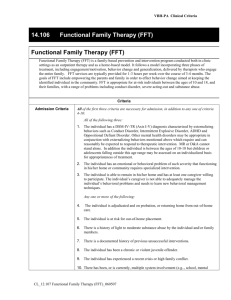
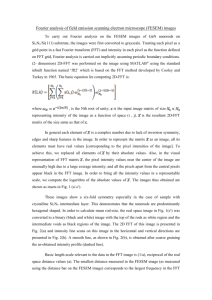

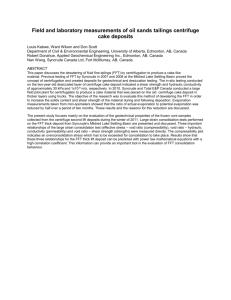
![Y = fft(X,[],dim)](http://s2.studylib.net/store/data/005622160_1-94f855ed1d4c2b37a06b2fec2180cc58-300x300.png)
